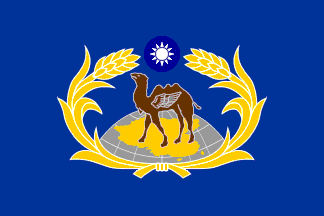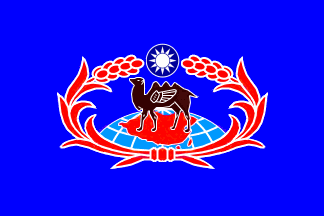
image by Akira Oyo and Miles Li, 03 June 2014
(de jure since 1973, de facto since circa 1992)

Last modified: 2020-07-11 by ian macdonald
Keywords: logistics command | taiwan | camel: three humped winged | map |
Links: FOTW homepage |
search |
disclaimer and copyright |
write us |
mirrors

image by Akira Oyo and Miles Li, 03 June 2014
(de jure since 1973, de facto since circa 1992)
See also:
From the Logistics Command website:
The development of the logistics command can be traced back to the military headquarters (1926-1928). After the war with the communists (1928-1937), the headquarters was merged into the Department of Military Affairs. During war against Japan (1937-1945), the logistics command was placed under the command of the Department of Military Affairs as logistics department. The authentic and modernized joint logistics system started after victory against Japan. The government combined "Joint Logistics Command" at Nanking on 1st of June, 1945 from the original Department of Military Affairs together with some section of military training in accordance with trends in military organization and also to cope with the integral needs of peaceful and war times. This move established the great tradition of the Chinese logistics system. In 1949 when the government failed in the war against the communists, and was forced to be relocated to Taiwan, President Chiang assumed the presidency, and ordered the logistics command to be re-instituted on 1st of April 1950. Later on, this department became responsible for the production of military arms and equipment, and provided joint back-up and general support for military services. It has constantly enhanced its production skill quality, and improved military arms. In joint logistics back-up, it has well and closely coordinated supply, repair and maintenance, and transportation to achieve the objectives of "short flow-process, fast speed, easy procedure, and high efficiency.
In terms of general logistics back-up, the command, based on its spirit of service, works to achieve the objectives of being "good, fast, convenient, and comprehensive." To cope with the two national defense laws as well as in order to streamline the numbers and tasks of servicemen as stated in the project enacted on 1st of March, 2002, the department was re-grouped under "Logistics Command of the Ministry of National Defense." Its major responsibilities of production, measurement, construction, stand-by were transferred to the Military Equipment Bureau of the Ministry of National Defense and the Reserve Command of the Ministry of National Defense. For the time being, the Logistics Command specializes in research support so that the information machinery of the Tri-service could be modernized and equipment be allocated directly, swiftly, and efficiently. This helps enhance combat capability. The Logistics Command appreciates its tremendous responsibility, and strives to contribute whatever it can toward a greater innovation and strengthen our national defense force.
Combined Service Forces
(CSF) was established on June 1st, 1946 in Nanjing,
China. In end of August in 1949, it was dismissed because of the Chinese Civil
War. After retreated to Taiwan, the KMT Government recovered CSF on April 1st,
1950.
On March 1st, 2002, CSF was officially renamed as "Combined Logistics Command of
the Ministry of National Defense" (CLC). However, the English name for the
flags was kept.
On December 28th, 2012, CLC was dismissed again and merged into Taiwanese Army
Logistics Command. The flags were abolished on the same day.
Akira Oyo, 04 June 2014
Blue with the emblem, the main element being a camel standing on a map of
China. Emblem shown here.
Jan Mertens, 21 July 2007
Not just any camel, a "winged" camel. Is the
map supposed to be the whole of the old ROC claim, including Mongolia?
Eugene Ipavec, 22 July 2007
And Tuva, too!
António Martins-Tuválkin, 22 July 2007

image by Eugene Ipavec, 22 July 2007
Source: Logistics Command
website